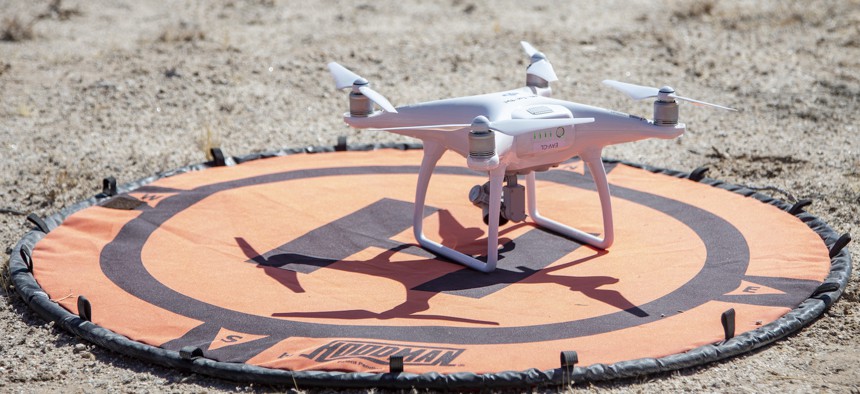
An Unmanned Aerial System is staged on a mobile landing zone as U.S. Marines with 3rd Low Altitude Air Defense Battalion conduct Counter-UAS training with Marine Operational Test and Evaluation Squadron 1 in Yuma, Arizona, July 30, 2020. U.S. Marine Corps / Lance Cpl. Larisa Chavez
Sergeant Makes One Counter-Drone Trainer to Rule Them All
Having too many different counter-drone systems is making training unnecessarily difficult. An Army National Guardsman from CENTCOM has developed a solution.
U.S. troops serving in places that are vulnerable to drone attack have many different counter-drone systems to choose from. But that’s a curse as well as a blessing, as it forces operators to stay up to date on a menagerie of different systems. But Army National Guard Sgt. Mickey Reeve, one of the winners of CENTCOM’s recent Innovation Oasis competition, developed a solution: a virtual trainer that allows operators to develop their skills across multiple systems at once.
Reeve, with the 1-182nd Infantry Regiment serving at Prince Sultan Air Base in Saudi Arabia, said there are so many different types of counter-drone systems, it can be hard for operators to stay up to date on all of them.
“Right now, what counter-[unmanned aerial system, or UAS] looks like at most locations is multiple proprietary independent counter-UAS systems,” he told Defense One, explaining that proprietary systems can’t talk to each other. That makes it very difficult to train on all the systems at once, which causes other problems for commanders trying to plan base security. “If we aren’t able to have all the systems running concurrently and running the same training scenario across all systems, then it becomes hard to create that training for teams and training for leaders,” he said.
Reeve developed a software tool that allows operators “to train concurrently across all of our systems, at the same time.”
The software isn’t intended for relatively easy-to-use handheld systems, but the much larger drones that use multiple sensors and electronic means to jam or interfere with drones.
Adversary drones have become a major concern around the world, particularly in Ukraine. The drones Russia is using to target infrastructure in Ukraine are from Iran, the State Department confirmed Thursday.
“The United States began warning in July that Iran was planning to transfer UAVs to Russia for use in Russia’s brutal war against Ukraine, and we now have abundant evidence that these UAVs are being used to strike Ukrainian civilians and critical civilian infrastructure,” State Department spokesman Ned Price said in a statement.
“What that means, obviously, again, we continue to see Iran be complicit in terms of exporting terror, not only in the Middle East region, but now also to Ukraine,” Pentagon spokesman Air Force Brig. Gen. Pat Ryder said Thursday.
Jennifer Hlad contributed to this post.




